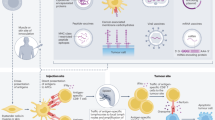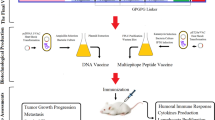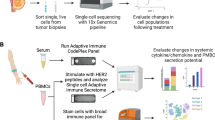Abstract
Prostate cancer is the most common malignant tumor in men and is normally associated with increased serum levels of prostate-specific antigen (PSA). Therefore, PSA is one potential target for a prostate cancer vaccine. In this study we analyzed the functionality of new bacterial PSA vaccines, expressed and secreted via the hemolysin (HlyA) secretion system of Escherichia coli, the prototype of Type I secretion systems (T1SS) using an attenuated Salmonella enterica serovar Typhimurium aroA strain as carrier. The data demonstrate that a bacterial live vaccine encompassing T1SS in combination with cholera toxin subunit B can be successfully used for delivery of PSA to induce cytotoxic CD8+ T-cell responses resulting in an efficient prevention of tumor growth in mice.
This is a preview of subscription content, access via your institution
Access options
Subscribe to this journal
Receive 12 print issues and online access
$259.00 per year
only $21.58 per issue
Buy this article
- Purchase on Springer Link
- Instant access to full article PDF
Prices may be subject to local taxes which are calculated during checkout




Similar content being viewed by others
References
Jemal A, Siegel R, Ward E, Murray T, Xu J, Smigal C et al. Cancer statistics, 2006. CA Cancer J Clin 2006; 56: 106–130.
Lilja H, Oldbring J, Rannevik G, Laurell CB . Seminal vesicle-secreted proteins and their reactions during gelation and liquefaction of human semen. J Clin Invest 1987; 80: 281–285.
Oakley N . Clinical implications of prostate-specific antigen (PSA). Curr Opin Urol 1998; 8: 401–406.
Heiser A, Coleman D, Dannull J, Yancey D, Maurice MA, Lallas CD et al. Autologous dendritic cells transfected with prostate-specific antigen RNA stimulate CTL responses against metastatic prostate tumors. J Clin Invest 2002; 109: 409–417.
Barrou B, Benoit G, Ouldkaci M, Cussenot O, Salcedo M, Agrawal S et al. Vaccination of prostatectomized prostate cancer patients in biochemical relapse, with autologous dendritic cells pulsed with recombinant human PSA. Cancer Immunol Immunother 2004; 53: 453–460.
Perambakam S, Hallmeyer S, Reddy S, Mahmud N, Bressler L, DeChristopher P et al. Induction of specific T cell immunity in patients with prostate cancer by vaccination with PSA146-154 peptide. Cancer Immunol Immunother 2006; 55: 1033–1042.
Arlen PM, Gulley JL, Parker C, Skarupa L, Pazdur M, Panicali D et al. A randomized phase II study of concurrent docetaxel plus vaccine versus vaccine alone in metastatic androgen-independent prostate cancer. Clin Cancer Res 2006; 12: 1260–1269.
Miller AM, Ozenci V, Kiessling R, Pisa P . Immune monitoring in a phase 1 trial of a PSA DNA vaccine in patients with hormone-refractory prostate cancer. J Immunother 2005; 28: 389–395.
Mabjeesh NJ, Zhong H, Simons JW . Gene therapy of prostate cancer: current and future directions. Endocr Relat Cancer 2002; 9: 115–139.
Paglia P, Medina E, Arioli I, Guzman CA, Colombo MP . Gene transfer in dendritic cells, induced by oral DNA vaccination with Salmonella typhimurium, results in protective immunity against a murine fibrosarcoma. Blood 1998; 92: 3172–3176.
Zoller M, Christ O . Prophylactic tumor vaccination: comparison of effector mechanisms initiated by protein versus DNA vaccination. J Immunol 2001; 166: 3440–3450.
Luo Y, Zhou H, Mizutani M, Mizutani N, Reisfeld RA, Xiang R . Transcription factor Fos-related antigen 1 is an effective target for a breast cancer vaccine. Proc Natl Acad Sci USA 2003; 100: 8850–8855.
Xiang R, Mizutani N, Luo Y, Chiodoni C, Zhou H, Mizutani M et al. A DNA vaccine targeting survivin combines apoptosis with suppression of angiogenesis in lung tumor eradication. Cancer Res 2005; 65: 553–561.
Zhao M, Yang M, Li XM, Jiang P, Baranov E, Li S et al. Tumor-targeting bacterial therapy with amino acid auxotrophs of GFP-expressing Salmonella typhimurium. Proc Natl Acad Sci USA 2005; 102: 755–760.
Holmgren J, Adamsson J, Anjuere F, Clemens J, Czerkinsky C, Eriksson K et al. Mucosal adjuvants and anti-infection and anti-immunopathology vaccines based on cholera toxin, cholera toxin B subunit and CpG DNA. Immunol Lett 2005; 97: 181–188.
Lycke N . Targeted vaccine adjuvants based on modified cholera toxin. Curr Mol Med 2005; 5: 591–597.
Sadeghi H, Bregenholt S, Wegmann D, Petersen JS, Holmgren J, Lebens M . Genetic fusion of human insulin B-chain to the B-subunit of cholera toxin enhances in vitro antigen presentation and induction of bystander suppression in vivo. Immunology 2002; 106: 237–245.
Yuki Y, Byun Y, Fujita M, Izutani W, Suzuki T, Udaka S et al. Production of a recombinant hybrid molecule of cholera toxin-B-subunit and proteolipid-protein-peptide for the treatment of experimental encephalomyelitis. Biotechnol Bioeng 2001; 74: 62–69.
Arakawa T, Yu J, Chong DK, Hough J, Engen PC, Langridge WH . A plant-based cholera toxin B subunit-insulin fusion protein protects against the development of autoimmune diabetes. Nat Biotechnol 1998; 16: 934–938.
Gentschev I, Mollenkopf H, Sokolovic Z, Hess J, Kaufmann SH, Goebel W . Development of antigen-delivery systems, based on the Escherichia coli hemolysin secretion pathway. Gene 1996; 179: 133–140.
Hess J, Gentschev I, Miko D, Welzel M, Ladel C, Goebel W et al. Superior efficacy of secreted over somatic antigen display in recombinant Salmonella vaccine induced protection against listeriosis. Proc Natl Acad Sci USA 1996; 93: 1458–1463.
Ryan ET, Butterton JR, Zhang T, Baker MA, Stanley Jr SL, Calderwood SB . Oral immunization with attenuated vaccine strains of Vibrio cholerae expressing a dodecapeptide repeat of the serine-rich Entamoeba histolytica protein fused to the cholera toxin B subunit induces systemic and mucosal antiamebic and anti-V. cholerae antibody responses in mice. Infect Immun 1997; 65: 3118–3125.
Gomez-Duarte OG, Pasetti MF, Santiago A, Sztein MB, Hoffman SL, Levine MM . Expression, extracellular secretion, and immunogenicity of the Plasmodium falciparum sporozoite surface protein 2 in Salmonella vaccine strains. Infect Immun 2001; 69: 1192–1198.
Gentschev I, Dietrich G, Goebel W . The E. coli alpha-hemolysin secretion system and its use in vaccine development. Trends Microbiol 2002; 10: 39–45.
Li Y, Reichenstein K, Ullrich R, Danner T, von Specht BU, Hahn HP . Effect of in situ expression of human interleukin-6 on antibody responses against Salmonella typhimurium antigens. FEMS Immunol Med Microbiol 2003; 37: 135–145.
Gentschev I, Fensterle J, Schmidt A, Potapenko T, Troppmair J, Goebel W et al. Use of a recombinant Salmonella enterica serovar Typhimurium strain expressing C-Raf for protection against C-Raf induced lung adenoma in mice. BMC Cancer 2005; 5: 15.
Wei C, Willis RA, Tilton BR, Looney RJ, Lord EM, Barth RK et al. Tissue-specific expression of the human prostate-specific antigen gene in transgenic mice: implications for tolerance and immunotherapy. Proc Natl Acad Sci USA 1997; 94: 6369–6374.
Datsenko KA, Wanner BL . One-step inactivation of chromosomal genes in Escherichia coli K-12 using PCR products. Proc Natl Acad Sci USA 2000; 97: 6640–6645.
Laemmli UK . Cleavage of structural proteins during the assembly of the head of bacteriophage T4. Nature 1970; 227: 680–685.
Fensterle J, Schwartz V, Riedmiller H, Rapp UR . Animal models for DNA vaccination against prostate cancer using PSA encoding plasmids. Onkologie 2005; 28 (Suppl 2): 52.
Fensterle J, Grode L, Hess J, Kaufmann SHE . Effective DNA vaccination against listeriosis by prime/boost inoculation with the gene gun. J Immunol 1999; 163: 4510–4518.
Gentschev I, Dietrich G, Mollenkopf HJ, Sokolovic Z, Hess J, Kaufmann SH et al. The Escherichia coli hemolysin secretion apparatus–a versatile antigen delivery system in attenuated Salmonella. Behring Inst Mitt 1997; 95: 103–113.
Gentschev I, Hess J, Goebel W . Change in the cellular localization of alkaline phosphatase by alteration of its carboxy-terminal sequence. Mol Gen Genet 1990; 222: 211–216.
Boon T, Coulie PG, Van den Eynde BJ, van der Bruggen P . Human T cell responses against melanoma. Annu Rev Immunol 2006; 24: 175–208.
Rosenberg SA . Progress in human tumour immunology and immunotherapy. Nature 2001; 411: 380–384.
Dunn GP, Old LJ, Schreiber RD . The immunobiology of cancer immunosurveillance and immunoediting. Immunity 2004; 21: 137–148.
Cardenas L, Clements JD . Oral immunization using live attenuated Salmonella spp. as carriers of foreign antigens. Clin Microbiol Rev 1992; 5: 328–342.
Ryan RM, Green J, Lewis CE . Use of bacteria in anti-cancer therapies. Bioessays 2006; 28: 84–94.
Kirby AC, Yrlid U, Wick MJ . The innate immune response differs in primary and secondary Salmonella infection. J Immunol 2002; 169: 4450–4459.
Brigl M, Bry L, Kent SC, Gumperz JE, Brenner MB . Mechanism of CD1d-restricted natural killer T cell activation during microbial infection. Nat Immunol 2003; 4: 1230–1237.
Holtmeier W, Kabelitz D . Gammadelta T cells link innate and adaptive immune responses. Chem Immunol Allergy 2005; 86: 151–183.
Reisfeld RA, Niethammer AG, Luo Y, Xiang R . DNA vaccines suppress tumor growth and metastases by the induction of anti-angiogenesis. Immunol Rev 2004; 199: 181–190.
Vassaux G, Nitcheu J, Jezzard S, Lemoine NR . Bacterial gene therapy strategies. J Pathol 2006; 208: 290–298.
Nishikawa H, Sato E, Briones G, Chen LM, Matsuo M, Nagata Y et al. In vivo antigen delivery by a Salmonella typhimurium type III secretion system for therapeutic cancer vaccines. J Clin Invest 2006; 116: 1946–1954.
Panthel K, Meinel KM, Sevil Domenech VE, Geginat G, Linkemann K, Busch DH et al. Prophylactic anti-tumor immunity against a murine fibrosarcoma triggered by the Salmonella type III secretion system. Microbes Infect 2006; 8: 2539–2546.
Wick MJ . Living in the danger zone: innate immunity to Salmonella. Curr Opin Microbiol 2004; 7: 51–57.
Bumann D . Regulated antigen expression in live recombinant Salmonella enterica serovar Typhimurium strongly affects colonization capabilities and specific CD4(+)-T-cell responses. Infect Immun 2001; 69: 7493–7500.
Harakuni T, Sugawa H, Komesu A, Tadano M, Arakawa T . Heteropentameric cholera toxin B subunit chimeric molecules genetically fused to a vaccine antigen induce systemic and mucosal immune responses: a potential new strategy to target recombinant vaccine antigens to mucosal immune systems. Infect Immun 2005; 73: 5654–5665.
Gentschev I, Dietrich G, Spreng S, Neuhaus B, Maier E, Benz R et al. Use of the α-hemolysin secretion system of Escherichia coli for antigen delivery in the Salmonella typhi Ty21a vaccine strain. Int J Med Microbiol 2004; 294: 363–371.
Gentschev I, Spreng S, Sieber H, Ures J, Mollet F, Collioud A et al. Vivotif—a ‘magic shield’ for protection against typhoid fever and delivery of heterologous antigens. Chemotherapy 2007; 53: 177–180.
Levine MM, Ferreccio C, Black RE, Germanier R . Large-scale field trial of Ty21a live oral typhoid vaccine in enteric-coated capsule formulation. Lancet 1987; 1: 1049–1052.
Acknowledgements
We thank G Dietrich for helpful discussions, Z Sokolovic and J Köhler for critical reading of the manuscript and J Reidl for the kind gift of V. cholerae DNA. This work was supported by grants from Aeterna Zentaris GmbH, Frankfurt (B Bergmann, CLRP Yone and I Gentschev) and from the Bavarian Research Cooperations Abayfor (Foringen; I Gentschev and UR Rapp).
Author information
Authors and Affiliations
Corresponding authors
Additional information
Competing interests
The authors declare that they have competing interests.
Rights and permissions
About this article
Cite this article
Fensterle, J., Bergmann, B., Yone, C. et al. Cancer immunotherapy based on recombinant Salmonella enterica serovar Typhimurium aroA strains secreting prostate-specific antigen and cholera toxin subunit B. Cancer Gene Ther 15, 85–93 (2008). https://doi.org/10.1038/sj.cgt.7701109
Received:
Revised:
Accepted:
Published:
Issue Date:
DOI: https://doi.org/10.1038/sj.cgt.7701109
Keywords
This article is cited by
-
Current advances in microbial-based cancer therapies
Medical Oncology (2023)
-
Metabolic engineering of probiotic Escherichia coli for cytolytic therapy of tumors
Scientific Reports (2021)
-
In situ delivery of biobutyrate by probiotic Escherichia coli for cancer therapy
Scientific Reports (2021)
-
The potential roles of bacteria to improve radiation treatment outcome
Clinical and Translational Oncology (2018)
-
Bacterial Delivery of Staphylococcus aureus α-Hemolysin Causes Regression and Necrosis in Murine Tumors
Molecular Therapy (2014)



